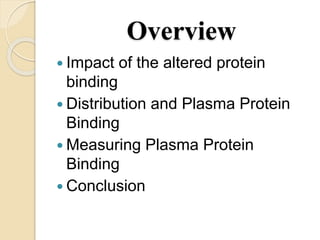Drug protein binding
- 1. Presentation on: Drug protein binding. Presentation by: ALI ASRAF SOHEL ID:2015000300008 Southeast university
- 2. Overview ï Impact of the altered protein binding ï Distribution and Plasma Protein Binding ï Measuring Plasma Protein Binding ï Conclusion
- 3. Impact of the altered protein binding âšOnly the unbound fraction of the drug undergoes metabolism in the liver and other tissues âš As the drug dissociates from the protein more and more drug undergoes metabolism âšChanges in the levels of free drug change the volume of distribution
- 4. âšRapidly undergo metabolism, clearance is dependent on the hepatic blood flow. âšSlowly undergo drug directly change the clearance of the drug. âšIf the amount of plasma protein is decreased (such as liver disease, renal disease), there would also be a higher fraction unbound.
- 5. Distribution and Plasma Protein Binding âšThe distribution of a drug is often measured as a volume of distribution. âšIt is also a measure of the fluid volume. âšIt is important to note that the measured volumes are not actual physical volumes.
- 6. Typical Liquid Volumes For A 70kg Man Are (% And L) ï Total Water: 60%, 42 L ï Intracellular Volume: 40%, 28L ï Extracellular Volume: 20%, 14L ï Plasma Volume: 4%, 3L ï Blood Volume: 8%, 5.5L
- 7. Measuring Plasma Protein Binding âšEquilibrium dialysis is the most widely accepted method for assessing plasma protein binding. âšBut is a relatively slow process, from 4-24 hours at 37 C. âšFor very highly bound compounds it can be difficult to measure the concentration of unbound drug.
- 8. Conclusion Overall we can say it drug protein binding is very important for drug distribution. In every step of drug distribution it plays an important role.







